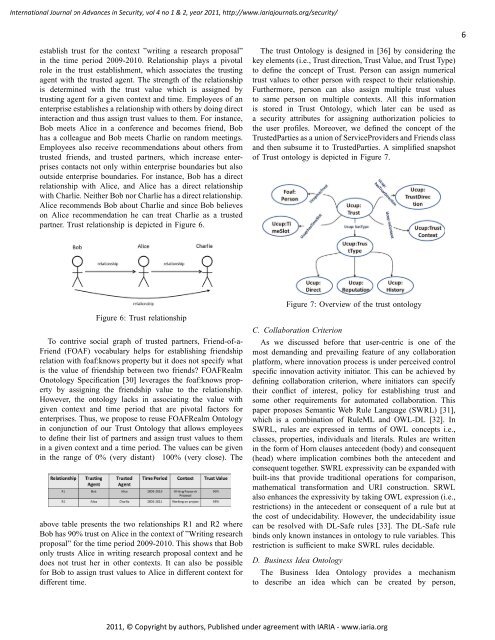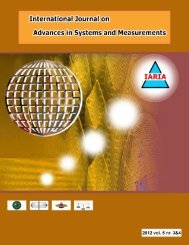Fault Tolerance Framework using Model-Based - IARIA Journals
Fault Tolerance Framework using Model-Based - IARIA Journals
Fault Tolerance Framework using Model-Based - IARIA Journals
Create successful ePaper yourself
Turn your PDF publications into a flip-book with our unique Google optimized e-Paper software.
International Journal on Advances in Security, vol 4 no 1 & 2, year 2011, http://www.iariajournals.org/security/<br />
establish trust for the context ”writing a research proposal”<br />
in the time period 2009-2010. Relationship plays a pivotal<br />
role in the trust establishment, which associates the trusting<br />
agent with the trusted agent. The strength of the relationship<br />
is determined with the trust value which is assigned by<br />
trusting agent for a given context and time. Employees of an<br />
enterprise establishes a relationship with others by doing direct<br />
interaction and thus assign trust values to them. For instance,<br />
Bob meets Alice in a conference and becomes friend, Bob<br />
has a colleague and Bob meets Charlie on random meetings.<br />
Employees also receive recommendations about others from<br />
trusted friends, and trusted partners, which increase enterprises<br />
contacts not only within enterprise boundaries but also<br />
outside enterprise boundaries. For instance, Bob has a direct<br />
relationship with Alice, and Alice has a direct relationship<br />
with Charlie. Neither Bob nor Charlie has a direct relationship.<br />
Alice recommends Bob about Charlie and since Bob believes<br />
on Alice recommendation he can treat Charlie as a trusted<br />
partner. Trust relationship is depicted in Figure 6.<br />
Figure 6: Trust relationship<br />
To contrive social graph of trusted partners, Friend-of-a-<br />
Friend (FOAF) vocabulary helps for establishing friendship<br />
relation with foaf:knows property but it does not specify what<br />
is the value of friendship between two friends? FOAFRealm<br />
Onotology Specification [30] leverages the foaf:knows property<br />
by assigning the friendship value to the relationship.<br />
However, the ontology lacks in associating the value with<br />
given context and time period that are pivotal factors for<br />
enterprises. Thus, we propose to reuse FOAFRealm Ontology<br />
in conjunction of our Trust Ontology that allows employees<br />
to define their list of partners and assign trust values to them<br />
in a given context and a time period. The values can be given<br />
in the range of 0% (very distant) 100% (very close). The<br />
above table presents the two relationships R1 and R2 where<br />
Bob has 90% trust on Alice in the context of ”Writing research<br />
proposal” for the time period 2009-2010. This shows that Bob<br />
only trusts Alice in writing research proposal context and he<br />
does not trust her in other contexts. It can also be possible<br />
for Bob to assign trust values to Alice in different context for<br />
different time.<br />
The trust Ontology is designed in [36] by considering the<br />
key elements (i.e., Trust direction, Trust Value, and Trust Type)<br />
to define the concept of Trust. Person can assign numerical<br />
trust values to other person with respect to their relationship.<br />
Furthermore, person can also assign multiple trust values<br />
to same person on multiple contexts. All this information<br />
is stored in Trust Ontology, which later can be used as<br />
a security attributes for assigning authorization policies to<br />
the user profiles. Moreover, we defined the concept of the<br />
TrustedParties as a union of ServiceProviders and Friends class<br />
and then subsume it to TrustedParties. A simplified snapshot<br />
of Trust ontology is depicted in Figure 7.<br />
Figure 7: Overview of the trust ontology<br />
C. Collaboration Criterion<br />
As we discussed before that user-centric is one of the<br />
most demanding and prevailing feature of any collaboration<br />
platform, where innovation process is under perceived control<br />
specific innovation activity initiator. This can be achieved by<br />
defining collaboration criterion, where initiators can specify<br />
their conflict of interest, policy for establishing trust and<br />
some other requirements for automated collaboration. This<br />
paper proposes Semantic Web Rule Language (SWRL) [31],<br />
which is a combination of RuleML and OWL-DL [32]. In<br />
SWRL, rules are expressed in terms of OWL concepts i.e.,<br />
classes, properties, individuals and literals. Rules are written<br />
in the form of Horn clauses antecedent (body) and consequent<br />
(head) where implication combines both the antecedent and<br />
consequent together. SWRL expressivity can be expanded with<br />
built-ins that provide traditional operations for comparison,<br />
mathematical transformation and URI construction. SRWL<br />
also enhances the expressivity by taking OWL expression (i.e.,<br />
restrictions) in the antecedent or consequent of a rule but at<br />
the cost of undecidability. However, the undecidability issue<br />
can be resolved with DL-Safe rules [33]. The DL-Safe rule<br />
binds only known instances in ontology to rule variables. This<br />
restriction is sufficient to make SWRL rules decidable.<br />
D. Business Idea Ontology<br />
The Business Idea Ontology provides a mechanism<br />
to describe an idea which can be created by person,<br />
2011, © Copyright by authors, Published under agreement with <strong>IARIA</strong> - www.iaria.org<br />
6







